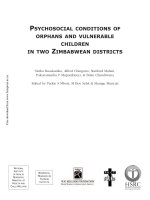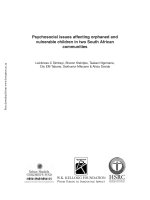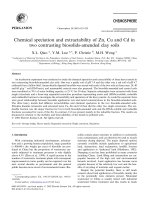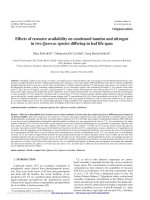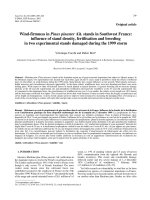Electrical spin injection and transport in two dimensional carbon materials
Bạn đang xem bản rút gọn của tài liệu. Xem và tải ngay bản đầy đủ của tài liệu tại đây (6.68 MB, 200 trang )
ELECTRICAL SPIN INJECTION AND TRANSPORT IN
TWO-DIMENSIONAL CARBON MATERIALS
ZHANG CHI
NATIONAL UNIVERSITY OF SINGAPORE
2013
ELECTRICAL SPIN INJECTION AND TRANSPORT IN
TWO-DIMENSIONAL CARBON MATERIALS
ZHANG CHI
(B. Eng. Hons, National University of Singapore, 2009)
A THESIS SUBMITTED
FOR THE DEGREE OF DOCTOR OF PHILOSOPHY
NUS GRADUATE SCHOOL FOR INTEGRATIVE SCIENCES AND
ENGINEERING
NATIONAL UNIVERSITY OF SINGAPORE
2013
ACKNOWLEDGEMENT
I would like to express deepest appreciation to all those people who provided help
to finish this dissertation. The years studying at National University of Singapore have
been and will be one of the most important phases in my life to shape my perspective
and define my career path. During this vital time, my supervisor Prof. Wu Yihong has
provided invaluable guidance, stimulating suggestions and encouragement. His novel
and direction-defining ideas and concepts built the foundation of my work. Moreover,
his passion and devotion towards the field of research inspired me to always give my
very best during the last four years. Hereby, I would like to take this opportunity to
express my sincere gratitude and appreciation to him.
Also, I would like to thank my fellow group members, Dr. Wu Baolei, Mr. Wang
Ying, Mr. Yang Yumeng, and Dr. Huang Leihua for their crucial help towards my work
and all the fruitful discussions I held with them. I hope for the best for my junior
students to achieve breakthroughs in their field of study soon and for my seniors I wish
them good luck in their future career.
All the other staff and students in our laboratory have always been nice and
supporting. I am grateful for Mr. Kulothungasagaran Narayanapillai, Mr. Praveen
Deorani, Mr. Velleyur Nott Siddharth Rao, Mr. Kwon Jae-Hyun, Mr. Ding Junjia, Mr.
Liu Xinming, Ms. Loh Fong Leong, and Ms. Xiao Yun for all their help, especially Mr.
Kulothungasagaran Narayanapillai, who was always ready to give a hand during my
sample fabrication process.
ii
Last but not at least, my heartfelt appreciation goes for the most important people
in my life. My wife and family never failed to encourage me and stand behind me during
difficult times. I would have never accomplished this without their indefinite love and
support.
Zhang Chi
August 2013
iii
TABLE OF CONTENTS
ACKNOWLEDGEMENT i
TABLE OF CONTENTS iii
SUMMARY vi
LIST OF FIGURES viii
LIST OF TABLES xvi
LIST OF SYMBOLS xvii
LIST OF ABBREVIATIONS xx
LIST OF PUBLICATIONS xxii
CHAPTER 1 INTRODUCTION 1
1.1 Background 1
1.2 Introduction to graphene 5
1.3 Graphene spintronics 7
1.4 Motivation of this work 15
1.5 Thesis organization 18
References 22
CHAPTER 2 PHYSICS OF GRAPHENE SPINTRONICS 28
2.1 Introduction 28
2.2 Graphene band structure 28
2.3 Mobility in graphene 32
2.4 Spin-orbit coupling in graphene 34
2.4.1 Intrinsic spin-orbit coupling 34
2.4.2 Spin relaxation in graphene 36
2.4.3 Rashba spin-orbit coupling in graphene 37
2.5 Edge magnetic ordering of graphene 39
2.6 Spin injection into graphene 43
2.6.1 Ferromagnetic/nonmagnetic junction 43
2.6.2 Ferromagnetic/nonmagnetic/ferromagnetic trilayer 49
2.6.3 Non-local spin valve 53
2.7 Metal/graphene contact 56
2.7.1 Physisorption and chemisorption interface 56
2.7.2 Experimental values of contact resistivity 61
2.8 Conclusion 64
References 65
iv
CHAPTER 3 ELETRICAL TRANSPORT MEASUREMENTS OF METAL/
GRAPHENE CONTACTS 70
3.1 Introduction 70
3.2 Sample fabrication 70
3.2.1 Mechanical exfoliation of graphene 70
3.2.2 Patterning and deposition of electrodes 72
3.3 Experimental setup 76
3.4 Experimental results 79
3.4.1 Evaporated Co/Cu/graphene and Cu/graphene devices 79
3.4.2 Sputtered Co/Cu/graphene and Co/graphene devices 82
3.4.3 Comparison among the four types of devices 83
3.4.4 Low temperature measurements of evaporated devices 85
3.4.5 Low temperature measurements of sputtered devices 90
3.5 Conclusion 91
References 93
CHAPTER 4 MR MEASUREMENTS OF GRAPHENE SPIN VALVES WITH A Cu
INTERFACIAL LAYER 95
4.1 Introduction 95
4.2 Measurement methodology 95
4.3 Experimental results 97
4.3.1 Background resistance 97
4.3.2 Devices with different Cu thickness 99
4.3.3 MR dependence on DC bias 110
4.4 Spin lifetime and injection efficiency comparison with literature 112
4.4.1 Spin lifetime 112
4.4.2 Spin injection efficiency and contact resistivity 117
4.5 Conclusion 121
References 123
CHAPTER 5 MR IN NiFe/Cu/GRAPHENE TRILAYER STRUCTURE 125
5.1 Introduction 125
5.2 Sample design and measurement methodology 125
5.3 Experimental results 127
5.3.1 MR measurements of NiFe/Cu and NiFe/graphene structure 127
5.3.2 MR measurements of NiFe/Cu/graphene structure 128
5.4 Possible origins for the low-field MR peak 133
5.4.1 Weak localization 133
5.4.2 Rashba induced spin-dependent band splitting inside graphene 139
5.5 Conclusion 142
References 142
v
CHAPTER 6 STUDY OF Ni-CNW MAGNETOMECHANICAL NANOCONTACT IN
UHV 143
6.1 Introduction 143
6.2 Ballistic magnetoresistance in magnetic nano-contacts 144
6.3 Experimental setup 147
6.4 Experimental results 150
6.4.1 Magnetomechanical resistance change 150
6.4.2 Calculation for the tip deflection distance 154
6.4.3 Linear response to a time varying magnetic field 155
6.5 Conclusion 159
References 161
CHAPTER 7 CONCLUSION AND FUTURE WORK 162
7.1 Conclusion 162
7.2 Future work 164
References 169
APPENDIX A: 170
APPENDIX B: 171
APPENDIX C: 173
vi
SUMMARY
Two-dimensional carbon materials including single and few layer graphene
sheets are promising for spintronic applications due to their peculiar electronic
properties, including small spin-orbit coupling, high carrier mobility, and ease with
carrier type and conductivity control through electric gating. As carbon itself is usually
non-magnetic, one of the prerequisites for realizing carbon-based spintronics is the
establishment of high-efficient spin-injection techniques for injecting from spin
polarized sources into carbon. Both theoretical and experimental studies have shown
that spin-injection efficiency between magnetic metal and graphene is limited by the
conductivity mismatch, as is with the case of metal-semiconductor contact. Although
the spin injection efficiency can be boosted significantly by inserting an insulating
barrier between metal and graphene, the high-contact resistance may pose problems
eventually in high-frequency and low power applications. In this context, the possibility
of forming a high spin injection efficiency contact with a moderate contact resistance
is explored in this work.
We investigated the contact formed in a Co (or NiFe)/Cu/graphene structure. The
Cu interfacial layer was introduced based on the consideration that Co (or NiFe)/Cu
interface is the most widely studied and representative interface for metal-based
spintronic devices and at the same time the atomic bonding between Cu and graphene
is weak. Lateral spin-vale type of devices were fabricated on mechanically exfoliated
few-layer graphene and their magnetotransport properties were characterized using
vii
both local and non-local magnetoresistance measurements at variable temperatures.
A moderate barrier height of 33 - 45 meV was found at the Cu/graphene interface.
A clear enhancement of spin-injection efficiency was demonstrated as compared to
other graphene based spin valve devices incorporating transparent contacts in literature.
The spin injection efficiency is able to reach values comparable to devices with low
impedance tunnel barriers. On the other hand, the contact resistance remains orders of
magnitude lower than tunnel contacts. Besides non-local magnetoresistance signals, a
magnetoresistance peak is observed around zero magnetic field in the
NiFe/Cu/graphene trilayer structure. A possible origin of this signal is discussed
invoking Rashba spin splitting.
Besides being employed as a non-magnetic channel material for spintronic
applications, graphene can be made magnetic through edge engineering. Theoretical
studies predict the existence of magnetic ordering at the edge of graphene nanoribbons.
We attempted to probe this edge magnetism by using a nano-contact between Ni and
carbon nanowalls. The carbon nanowalls are few-layer graphene sheets grown
vertically on the substrate. Although extremely large magnetoresistance-like features
with well-defined hysteresis were observed, it was found that the effect is of
magnetomechanical nature in which spatial displacement of the Ni tip is inevitable
when subjected to a magnetic field. Nevertheless, the results are of significance since
they provide evidences that the so-called ballistic magnetoresistance in various forms
of nano-contacts reported in literature is of extrinsic origins.
viii
LIST OF FIGURES
FIG. 1.1
Schematic of the operation principle of Datta-Das spin FET. Figure modified
from Ref. 11.
3
FIG. 1.2
(a) The non-local and (b) local spin valve signal plotted as a function of the
ratio between the contact resistance R
C
and NM characteristic spin resistance
R
NM
. This theoretical calculation is based on Eq. (2.32), Eq. (2.33) and Eq.
(2.37) discussed in Section 2.6. Typical R
FM
/R
NM
ratio of 0.012 for Co and
graphene is used. Diamonds (triangles) represent R
S
data points for
transparent (tunnel) contacts extracted from literature.
11
FIG. 2.1
(a) Schematic for the honeycomb structure of graphene with its inequivalent
lattice sites A and B, the corresponding interpenetrating triangular lattices a
1
and a
2
, and the nearest neighbour vectors δ
1,2,3
. (b) The Brillouin zone in
reciprocal space, with Dirac cones located at the K and K’ points. Figure
adapted from Ref. 2.
29
FIG. 2.2
Band dispersion of graphene. The left side represents the entire energy band
structure, while the right side zooms in to the energy band near the Dirac
point. Figure adapted from Ref. 2.
31
FIG. 2.3
The calculated band structures of (a) armchair and (b) zigzag graphene
nanoribbons. Figure adapted from Ref. 51.
40
FIG. 2.4
(a) Contour plots of the ferromagnetically ordered spin densities in an
isolated zigzag graphene nanoribbon with open edges. Red and blue denote
opposite spin orientations. The direction of an external electric field is
indicated in the figure. Figure adapted from Ref. 52. (b) Left (right) panel
shows the spin-resolved band structures of the nanoribbon without (with) and
transverse electric field. Red and blue indicate α spin and β spin states,
respectively. Figure adapted from Ref. 50.
41
FIG. 2.5
DOS diagram of the electronic states of a graphene nanoribbon (a) without
applied electric field and (b) with applied transverse field. Top: the occupied
and unoccupied edge states on the left side are for α-spin and β-spin,
respectively, and vice versa on the right side. Bottom: Schematic of the
spatial spin distribution in the highest occupied VB. Figure adapted from
Ref. 42.
42
FIG. 2.6
(a) Schematic showing the spin injection process from a FM on the left into
a NM material on the right. (b) When spin-polarized current from the FM
reaches the interface, spin accumulation is generated. A splitting between the
44
ix
spin-up (+) and spin-down (-) electro-chemical energies is induced and the
spin accumulation is derived as Δμ = (μ
+
−μ
−
). (c) The variation of the current
spin polarization throughout the FM/NM junction. Figure modified from
Ref. 54.
FIG. 2.7
(a) Spin accumulation in logarithmic scale and (b) current spin polarization
at the interface between a FM metal and a semiconductor NM. The
calculation has been carried out for FM as Co with r
FM
= 4.5 × 10
−15
Ω·m
2
[60, 61], p
FM
= 0.46, and λ
FM
= 60 nm [60], and for NM as GaAs with r
NM
=
4.5 × 10
−9
Ω·m
2
and λ
NM
= 2 μm [59]. The blue solid lines are calculated with
spin-dependent contact resistance of r
C
= r
NM
= 4 × 10
−9
Ω·m
2
, P
J
= 0.5, and
the red dashed lines without contact resistance. Figure modified from Ref.
59.
48
FIG. 2.8
Spin splits of the electro-chemical potential Δµ and current densities J
±
for a
FM/NM/FM multilayer with spin-dependent scattering in the (a), (b) AP
magnetization configuration, and (c), (d) P magnetization configuration.
Figure adapted from Ref. 56.
50
FIG. 2.9
Calculated MR ratio of a FM/NM/FM trilayer plotted as a function r
C
/r
NM
.
r
FM
/r
NM
is taken to be 0.012 which simulates the case of Co and graphene.
λ
NM
/L
NM
is assumed to be 0.1.
53
FIG. 2.10
Basic structure of a non-local spin injection and detection device where the
bias current density J is separated from the detection terminal.
54
FIG. 2.11
Calculated MR signal of a non-local spin valve plotted as a function r
C
/r
NM
.
r
FM
/r
NM
is taken to be 0.012 which simulates the case of Co and graphene.
λ
NM
/L
NM
is assumed to be 0.1.
55
FIG. 2.12
Energy band diagrams for (a) metal/semiconductor (Schottky barrier case),
(b) metal/metal, and (c) metal/graphene junctions (p-doped graphene case).
Figure modified from Ref. 67.
57
FIG. 2.13
Schematic of the band diagram of the metal/graphene interface with the
illustration of the parameters which are implemented in the planar
capacitance model. Figure adapted from Ref. 70.
58
FIG. 2.14
The metal/graphene binding energy (upper panel) and the metal/graphene
atomic distance of different metals (lower panel). The metal/graphene
interface can be divided into two categories: Physisorption and
chemisorption interface.
60
FIG. 3.1
Mechanical exfoliation of graphene.
71
x
FIG. 3.2
AFM images of (a) single layer, (b) bilayer and (c) trilayer graphene.
Measured thickness is 0.42 nm, 0.81 nm, 1.24 nm, respectively, as depicted
in the cross section in (d), (e), (f).
72
FIG. 3.3
The sample fabrication process.
73
FIG. 3.4
(a) Schematic of the device with dimensions indicated. (b) An optical
microscope image of the actual device.
74
FIG. 3.5
Schematic of the four types of devices. (a), (b) The Type I and II devices are
fabricated by evaporation with and without the Cu interfacial layer,
respectively. (c), (d) The Type III and IV devices are fabricated by sputtering
with and without the Cu interfacial layer, respectively.
76
FIG. 3.6
(a) Schematic of the setup for I
ds
-V
ds
and dI
ds
/dV
ds
measurements.
Measurements were carried out under UHV environment in an Omicron
nanoprobe system and under low temperature in a LHe cryostat. (b), (c)
Schematic of the two terminal and four terminal measurement connections,
respectively. The latter is used for measuring the contact resistance.
77
FIG. 3.7
(a) I
ds
plotted against V
ds
at various V
G
for the Type I device. The different
color codes and symbols represent data measured at different V
G
. Inset:
(Field emission transport) FET characteristics of the sample showing the
Dirac point at -78V. (b) dI
ds
/dV
ds
curves plotted as a function of V
ds
and V
G
.
79
FIG. 3.8
(a) I
ds
plotted against V
ds
at various V
G
for the Type II device. The different
color codes and symbols represent data measured at different V
G
. Inset: FET
characteristics of the sample showing the Dirac point at -28V. (b) dI
ds
/dV
ds
curves plotted as a function of V
ds
and V
G
.
81
FIG. 3.9
(a), (b) I
ds
-V
ds
and dI
ds
/dV
ds
characteristics of the Type III device at various
V
G
. (c), (d) The same graphs for the Type IV device.
82
FIG. 3.10
(a) Back gate bias dependence of the conductance ratio taken at V
ds
= 1.5 V
and zero bias for each type of device. Square, circle, triangle, and diamond
represent data for the Type I device, Type II device, Type III device, and
Type IV device, respectively. (b) Schematic of R
c
and R
Ch
in series. (c)
Statistics of the contact resistivity ρ
C
of the four types of samples.
84
FIG. 3.11
(a) Conductance vs. V
ds
at various temperature from 250 K down to 4.2 K
for the Type I sample with 1.5 nm thick Cu interfacial layer. The gradual
formation of the dip at low V
ds
is seen. (b) The conductance of the graphene
channel at various temperatures. The curves show a maximum change of 2%
85
xi
between high and low V
ds
. (c) The contact conductance at various
temperatures. It is seen that the dip at low V
ds
originates from the contact and
not the channel. The conductance curves in this figure are vertically offset
for clarity, except for the lowest one in each panel.
FIG. 3.12
Temperature dependence of the contact resistivity of Type I samples with Cu
thickness of (a) 1.5 nm, (b) 2.5 nm, and (c) 3.5 nm, respectively. The
corresponding contact potential barrier height obtained from fitting the
experimental data with Eq. (3.1) are shown inside each panel. Squares denote
experimental data and the solid line is the fitting curve.
87
FIG. 3.13
(a), (b) Contact conductance plotted as a function of V
ds
from 250 K down to
4.2 K for the Type III and Type IV sample, respectively. For clarity, the
curves are vertically offset, except for the lowest one. (c), (d) Contact
resistivity plotted as a function of temperature for the Type III and Type IV
sample, respectively.
90
FIG. 4.1
(a) SEM image of the graphene spin valve device. (b) Schematic of the non-
local spin valve configuration. A current I flows from electrode 3 to electrode
4, while the voltage difference is picked up between electrodes 2 and 1. This
is equivalent to the geometry discussed in Section 2.6.3. (c) Schematic of
electron spin injection and diffusion when the electrodes are in P
configuration. Injection of spin up electrons at electrode 3 induces spin-up
accumulation underneath electrode 3, together with a deficit in the spin-down
channel. Due to the spin relaxation process, the spin density decays
exponentially within the spin relaxation length and a positive non-local
resistance is probed between electrode 1 and 2. (d) Electron spin injection
and diffusion for AP magnetization configurations. The voltage detectors
measure opposite spin channels, which give a negative non-local resistance.
Figure (b) – (d) adapted from Ref. 19.
96
FIG. 4.2
Background resistance plotted against gate bias of (a) the first and (b) second
1.5 nm Cu Type I sample.
98
FIG. 4.3
(a), (b), (c) show the AMR signal of the injector, detector, and the non-local
MR of the first Type I sample. (d), (e), (f) show the same set of data for the
second Type I sample. Inset of (a) and (b) show the measurement
configuration for the AMR signals, which also applies to (d) and (e),
respectively.
99
FIG. 4.4
(a), (b) Non-local MR curves obtained at various V
G
for two Type I devices
with 1.5 nm Cu thickness. A constant background is subtracted and the
curves are offset for clarity. (c) Spin valve signal of the two Type I devices
for forward magnetic sweep (square), backward sweep (circle), and average
100
xii
(triangle) plotted against V
G
. The fitting curve is shown as black solid
(dotted) line for the first (second) Type I device. The curves are offset for
clarity. Inset: FET response of the graphene channel resistance. Solid
(dotted) line for the first (second) Type I device.
FIG. 4.5
Non-local MR curves obtained at various V
G
for the Type I samples with Cu
thickness of (a) 2.5 nm, (b) 3.5 nm (first sample), and (c) 3.5 nm (second
sample). It should be noted that a background resistance of 1.1 Ω to 2.2 Ω is
subtracted and the MR curves are vertically offset for clarity. Experimental
(diamond) and fitted (solid line) spin valve signal plotted against V
G
for the
samples with Cu thickness of (d) 2.5 nm, (e) 3.5 nm (first sample), and (f)
3.5 nm (second sample).
101
FIG. 4.6
(a) Cross section TEM image of a sample with Cu thickness of 2.5 nm. (b)
Depth profile obtained by SIMS analysis of the Au/NiFe/Cu/graphene stack.
106
FIG. 4.7
AFM images of e-beam evaporated (a) 5 nm, (b) 2.5 nm and (c) 1.5 nm Cu
on graphene. The corresponding cross section with the thickness indicated is
shown in (d), (e), (f), respectively.
107
FIG. 4.8
(a) Current density simulation at the NiFe/Cu/graphene contact region with
Cu thickness of 2.5 nm (a) and 5 nm (b). The color scale represents the
normalized current density. Note that the NiFe and graphene layers extend
beyond this figure.
108
FIG. 4.9
Spin valve signal plotted against DC current bias at V
G
= -40 V (square), 0 V
(circle), 20 V (triangle). Inset: Spin valve signal plotted against temperature.
110
FIG. 4.10
Contact resistance obtained from fitting with Eq. (4.4) (line with square) and
actual measurement (solid line) plotted against DC current bias. Inset: Spin
injection efficiency plotted against DC current bias.
111
FIG. 4.11
(a) Hanle precession curves at various V
G
. It should be noted that the
background resistance is subtracted and the curves are vertically offset for
clarity. (b) Fitting curve (solid line) of the measured Hanle data (diamond) at
V
Dirac
= 30 V and the corresponding spin lifetime and diffusion constant
obtained. (c) Spin lifetime (square) and diffusion constant (triangle)
extracted from fitting of Hanle curves at various V
G
.
113
FIG. 4.12
(a) Contact spin polarization vs. contact resistivity comparison among
graphene spin valve devices with transparent (square), intermediate (circle)
and tunneling contacts (triangle). The references are indicated beside the
symbols. Circles denote data from this work. (b) Calculated cut-off
frequency for graphene FETs plotted against contact resistance at various
118
xiii
impurity concentrations.
FIG. 4.13
Schematic of the graphene based transistor with a top gate incorporating
HfO
2
dielectric.
120
FIG. 5.1
(a) Schematic of the NiFe/Cu/graphene trilayer structure with a Au capping
layer to prevent NiFe from oxidizing. (b) and (c) are control devices without
the graphene layer or without the Cu layer, respectively. The layer thickness
of Au, NiFe and Cu (if applicable) are 2 nm, 30 nm and 2.5 - 5 nm,
respectively.
126
FIG. 5.2
Schematic of the measurement connections. Throughout this chapter, all data
is obtained using the connection of (a) except for one set which incorporates
(b). The one using (b) is explicitly stated in the text.
127
FIG. 5.3
(a) AMR under parallel-to-plane magnetic field for a pure metal NiFe/Cu
bilayer. (b) AMR of a NiFe/graphene bilayer.
128
FIG. 5.4
(a) and (b) correspond to measurements for the low-field MR peak at various
back gate bias and temperatures, respectively. (a) is measured at 4.2 K. The
sample is a NiFe/Cu(2.5 nm)/graphene device. The curves are vertically
offset for clarity. (c) and (d) show the magnitude of the MR plotted against
V
G
and T, respectively.
129
FIG. 5.5
(a) MR measurements at various V
G
for a device with 3.5 nm Cu layer
thickness using the configuration as in Fig. 5.2 (a). (b) MR measurements
using a channel-inclusive configuration as depicted in Fig. 5.2 (b). The
curves are vertically offset for clarity. (c) and (d) show the low-field MR
peak plotted against V
G
for the two configurations, respectively.
130
FIG. 5.6
(a) Low-field MR peak measurements of the 5 nm Cu sample at various
temperature. It is noted that the AMR signal is not picked up since a large
field range is applied. The curves are vertically offset for clarity. (b) The
magnitude of the low-field MR peak compared among the three types of
samples with different Cu interfacial layer thicknesses. Red square
corresponds to 2.5 nm Cu, green triangle corresponds to 3.5 nm Cu, and blue
diamond corresponds to 5 nm Cu. It is clear that the 5 nm Cu sample exhibit
MR ratios which are significantly smaller than the other two types.
131
FIG. 5.7
(a) and (b) show the definitions of “backward-forward” and “forward-
backward” sweeping orders, respectively. (c) and (d) show the AMR
magnitude obtained during five runs of “backward-forward” and “forward-
backward” sweeps, respectively. (e) and (f) show the values of B
min
obtained
during five runs of “backward-forward” and “forward-backward” sweeps,
132
xiv
respectively. Red squares (blue triangles) correspond to the data obtained
during the forward (backward) sweep.
FIG. 5.8
(a) Two self-intersecting scattering loops of an electron with coherent phase
which can lead to constructive or destructive interference. The sizes of these
loops are determined by the dephasing time τ
Φ
related to elastic scattering.
(b) Three scattering mechanisms which contribute to phase change are
superimposed on the Fermi surface (triangle around the two Dirac points K
and K’): The elastic intervalley scattering time τ
i
; The elastic intravalley
trigonal warping scattering time τ
w
; The elastic intravalley chirality breaking
scattering time τ
z
. Adapted from Ref. 2.
134
FIG. 5.9
(a), (b), (c) Coherence lengths L
Φ
(red circle), L
i
(black square), and L
*
(blue
triangle) plotted as a function of T for the sample with 2.5 nm Cu, 3.5 nm Cu
and 5 nm Cu, respectively. (d) Coherence length values from literature. Filled
symbols are taken from Ref. 2, hollow symbols are taken from Ref. 3, and
crossed symbols are taken from Ref. 4.
136
FIG. 5.10
(a) The sample with 2.5 nm thick Cu layer is measured for MR under
perpendicular-to-plane magnetic field at 4.2K. The curves at different V
G
are
vertically offset for clarity. (b) MR curve obtained under large B
┴
sweep
range at 4.2 K and V
G
= 0. (c) Best approximation of a weak (anti-)
localization fitting using Eq. (5.1) to obtain the coherence lengths.
138
FIG. 5.11
(a) Schematic of Dirac cone of ideal graphene and after Rashba spin splitting
induced by Ni(111). Figure adapted from Ref. 8. (b) Angle-resolved
photoemission spectra near the graphene K point in a Ni(111)/Au/graphene
trilayer. The corresponding value of the wave vector k is indicated. Figure
adapted from Ref. 6. The blue and red lines represent the spin up and spin
down channel, respectively.
140
FIG. 6.1
(a) AFM image of CNWs. (b) MFM image of the CNWs with a section graph
corresponding to the white line in the MFM image. (c) Schematic of the Ni-
CNW nanocontact. The red dots denote the predicted edge magnetic
moments.
144
FIG. 6.2
Schematic of a magnetic nanocontact with the two sides of the contact in
antiparallel and parallel magnetic configuration. Blue and red indicate
regions of different magnetization.
145
FIG. 6.3
Schematic of the experimental setup. Measurements were carried out in the
Omicron UHV nanoprobe system.
148
FIG. 6.4
(a) SEM image of CNWs taken together with a nanoprobe using the in situ
149
xv
SEM. (b) Illustration of the contact formation between the nanoprobes and
CNWs and the measurement connection.
FIG. 6.5
MR curves obtained at various ZFR values represented by different symbols.
150
FIG. 6.6
(a) Color image showing the dependence of resistance on ZFR and applied
field. (b) The MR ratio as a function of ZFR. Diamonds are experimental
data, and the line is the corresponding trend line.
151
FIG. 6.7
The MR curve for a Ni-metal contact for reference.
152
FIG. 6.8
(a) Field modulation curve ΔR/ΔH plotted against the DC field. (b) MR curve
of a magnetic forward sweep.
156
FIG. 6.9
(a) Output waveforms of DC current biased nanocontact subjected to the
excitation of a small AC field superimposed with a variable DC field. The
values of the respective DC fields are given on the right side of the y-axis,
which are also marked by red diamonds in (b). (b) Different phases of the
magnetization configuration inside the tip during a magnetic forward sweep.
157
xvi
LIST OF TABLES
Table 1.1
Graphene based spin-valve devices and their performance from major
publications. T is the temperature and R
C
is the contact resistance. Note that
R
C
is given in different units. For the non-local geometry, the spin signal R
S
is shown, while for the local geometry, the MR ratio is given. The MR ratio
equals R
S
/R
P
, where R
P
is the resistance measured under parallel
magnetization configuration of the electrodes.
9
Table 2.1
List of contact resistivity of various metals on graphene from literature.
62
Table 4.1
A comparison for experimental zero bias R
C
measured at 4.2 K, R
C
obtained
through fitting, and experimental R
Ch
for graphene spin valves with various
Cu interfacial layer thickness.
104
Table 4.2
Summary of spin lifetime, diffusion constant and spin relaxation length
obtained through Hanle measurements from literature.
115
Table 5.1
Comparison between the coherence lengths obtained from the 2.5 nm Cu
sample under parallel-to-plane magnetic field, normal-to-plane magnetic
field, and coherence length values taken from literature.
139
Table C1
A list of parameters used to calculate the spin injection efficiency P
J
provided
by the author in their respective manuscript. R
S
is the spin valve signal, W is
the width of the graphene sheet, σ is the conductance of the graphene, L is
the spacing between the injector and detector, and λ
G
is the graphene spin
relaxation length.
173
xvii
LIST OF SYMBOLS
C
capacitance
C
G
gate capacitance
D
diffusion constant
e
elementary charge
E
energy
E*
electric field
E
F
Fermi level
g
s
spin degeneracy
g
v
valley degeneracy
h
Planck constant
ħ
reduced Planck constant
H
SO
spin-orbit coupling Hamiltonian
H
SO
I
graphene intrinsic spin-orbit coupling Hamiltonian
H
SO
R
Rashba spin-orbit coupling Hamiltonian
I
current
J
current density
k
wave vector
k
b
Boltzmann constant
k
F
Fermi wave vector
L
channel length
L
i
intervalley scattering coherence length
xviii
L
Φ
inelastic scattering coherence length
L
*
intravalley scattering coherence length
m
e
effective mass of electron
n
carrier density
n
i
impurity density
p
FM
polarization in ferromagnet
P
J
spin injection efficiency
r
C
contact resistance-area product
R
C
contact resistance
R
Ch
channel resistance
r
FM
resistance-area product of ferromagnet
R
FM
resistance of ferromagnet
r
NM
resistance-area product of non-magnet
R
NM
resistance of non-magnet
r
S
spin valve signal-area product
R
S
spin valve signal
T
temperature
V
voltage
V
Dirac
Dirac point voltage
V
ds
drain-source voltage
v
F
Fermi velocity
V
G
gate voltage
xix
Z
atomic number
λ
spin relaxation length
λ
FM
spin relaxation length in ferromagnet
λ
G
spin relaxation length in graphene
λ
NM
spin relaxation length in non-magnet
µ
electro-chemical potential
µ*
mobility
µ
FM
electro-chemical potential in ferromagnet
µ
NM
electro-chemical potential in non-magnet
ρ
C
contact resistivity
ρ
FM
resistivity of ferromagnet
ρ
NM
resistivity of non-magnet
σ
conductivity
τ
momentum relaxation time
τ
i
intervalley scattering time
τ
s
spin relaxation time
τ
Φ
inelastic scattering time
τ
*
intravalley scattering time
Φ
B
barrier potential
Φ
G
metal workfunction
Φ
M
graphene workfunction
xx
LIST OF ABBREVIATIONS
0D
zero-dimensional
1D
one-dimensional
2D
two-dimensional
2DEG
two-dimensional electron gas
3D
three-dimensional
AFM
atomic force microscope
AMR
anisotropic magnetoresistance
BMR
ballistic magnetoresistance
CB
conduction band
CMOS
complimentary metal-oxide-semiconductor
CNT
carbon nanotube
CNW
carbon nanowall
CPP
current-perpendicular-to-plane
DOS
density of states
EBL
electron-beam lithography
FET
field emission transistor
FM
ferromagnet
GMR
giant magnetoresistance
LHe
liquid helium
MFM
Magnetic force microscopy
xxi
MR
magnetoresistance
MTJ
Magnetic tunnel junction
NM
non-magnet
RF
radio frequency
rms
root mean square
RT
room temperature
SC
semiconductor
SEM
scanning electron microscope
SIMS
secondary ion mass spectroscopy
SNR
signal-to-noise ratio
TEM
transmission electron microscope
UHV
ultra-high vacuum
VB
valence band
YIG
yttrium iron garnet
ZFR
zero-field resistance
xxii
LIST OF PUBLICATIONS
Journal Publications:
1. Chi Zhang, Ying Wang, Leihua Huang, and Yihong Wu, Electrical transport study
of magnetomechanical nanocontact in ultrahigh vacuum using carbon nanowalls,
Applied Physics Letters 97, 062102 (2010).
2. Chi Zhang, Ying Wang, Baolei Wu, and Yihong Wu, Enhancement of spin injection
from ferromagnet to graphene with a Cu interfacial layer, Applied Physics Letters
101, 022406 (2012).
3. Chi Zhang, Ying Wang, Baolei Wu, and Yihong Wu, The effect of a copper interfacial
layer on spin injection from ferromagnet to graphene, Applied Physics A 111, 339
(2013), invited paper.
4. Chi Zhang, Ying Wang, Baolei Wu, and Yihong Wu, Effect of Cu interfacial layer
thickness on spin-injection efficiency in NiFe/Cu/graphene spin valves, Journal of
Applied Physics 113, 203909 (2013).
5. Ying Wang, Yumeng Yang, Zizheng Zhao, Chi Zhang, Yihong Wu, Local electron
field emission study of two-dimensional carbon, Applied Physics Letters 103,
033115 (2013).


